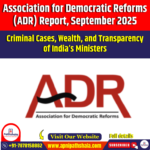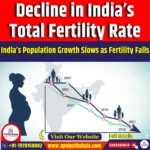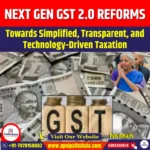|
GS Paper III: Growth & Development, Monetary Policy, Capital Market, Fiscal Policy, Banking Sector & NBFCs, Inclusive Growth |
Why in News?
The Economic Survey of India for 2024-25 was presented by Finance Minister Nirmala Sitharaman on January 31, 2025. The report offered an official assessment of the country’s economic performance for the current financial year. It also highlighted the key challenges India is likely to face in the coming period.
Economic Survey of India – Introduction
The Economic Survey of India is an essential annual document released by the Ministry of Finance. It offers a comprehensive analysis of the country’s economic performance. It is presented just a day before the Union Budget. It serves as a critical tool for policymakers, economists, and the public to assess the state of the Indian economy.
- It provides a detailed statistical account of India’s economy, including data on sectors like agriculture, industry, and services.
- The survey highlights the government’s achievements, focusing on key development programmes and initiatives over the past year.
- This economic document is presented to both Houses of the Parliament during the prescribed Budget Session.
- It discusses the government’s policy measures and suggests new strategies for the coming year to boost economic growth and address challenges.
- The survey also outlines the expected direction of the economy, helping stakeholders understand short to medium-term projections.
- It serves one of the most credible and updated sources for the Indian economy. It offers insights into various macroeconomic indicators, from GDP growth to inflation trends.
- India’s first Economic Survey was presented in 1950-51 by Dr. John Matthai, the Finance Minister at the time.
- Initially, it was presented alongside the Union Budget until 1964. From 1964 onwards, it has been delinked from the Budget.
- Though it is not mandated by the Constitution, the presentation of the Economic Survey of India has become a regular practice in the country’s economic planning.
Economic Survey of India – Preparation and Presentation
- Preparation:
- The first draft is created by the Economics Division of the Department of Economic Affairs, under the Ministry of Finance.
- The process is guided by the Chief Economic Advisor and the Secretary of Economic Affairs to ensure the document is comprehensive and accurate.
- After thorough scrutiny by the Finance Secretary, the final draft is approved by the Finance Minister before it is presented to Parliament.
- Presentation:
- This Economic Survey of India Report is presented annually in the Parliament during the Budget Session, typically one day before the Union Budget.
- The Finance Minister of India presents the Economic Survey in Parliament, giving an outline of the country’s economic outlook for the coming year.
Economic Survey of India – Structure
Since 2015, the Economic Survey of India has been traditionally presented in two parts. In this document each part focuses on different aspects of the nation’s economy.
- Volume 1: Comprehensive Economic Analysis
- Current Economic Situation: Volume 1 provides a thorough analysis of the country’s economic condition, including key indicators such as GDP growth, inflation, unemployment, and fiscal deficit.
- Policy Recommendations: This section also focuses on policy suggestions and outlines the government’s strategies for the upcoming year.
- Timing: Volume 1 is presented just before the Union Budget, serving as an introduction to the economic outlook.
- Volume 2: Sectoral Performance and Statistical Data
- Sectoral Insights: Volume 2 covers detailed data on various sectors of the economy, such as agriculture, industry, services, education, health, and infrastructure.
- Data-Driven Analysis: This volume is heavily data-centric. It provides statistical information and a deeper understanding of sectoral trends and challenges.
- Presentation Timing: Volume 2 is usually presented in July or August, following the budget presentation.
Economic Survey of India – Objectives
The Economic Survey of India plays a crucial role in presenting a detailed overview of the country’s economic situation and its future prospects.
- Economic Analysis: The primary aim of the Economic Survey is to analyze the economic achievements and challenges faced during the previous year. Its purpose is to provide an analytical framework. The survey highlights significant economic challenges and potential growth opportunities that can enhance the country’s development.
- Sectoral Analysis: The survey delves into different sectors of the economy such as agriculture, industry, services, and exports. It presents insights on potential improvements in these areas, focusing on growth opportunities and challenges.
- Policy Guidelines: The Economic Survey provides important policy recommendations, though it is not mandatory for the government to implement them. It acts as a guide for the upcoming Union Budget, shaping the policy framework for future economic decisions.
- Public Awareness: Economists, researchers, and students use the Economic Survey as a key reference to understand India’s economic trends and patterns. It plays a vital role in educating the public about the government’s economic strategies, encouraging better participation in decision-making processes.
Key Aspects of Economic Survey of India
The Economic Survey of India provides a thorough examination of the country’s economic performance, focusing on both macroeconomic indicators and specific areas of growth and development.
- Key Economic Indicators: The survey includes crucial data about the Gross Domestic Product (GDP) growth rate, which indicates the overall economic health of the country.
- Inflation and Unemployment: It presents the current state of inflation and unemployment. This highlights the challenges in managing price stability and job creation in india.
- Fiscal Deficit and Trade Balance: The document discusses the fiscal deficit, which reflects the gap between government expenditure and revenue, along with the trade balance to understand the flow of goods and services across borders.
- Thematic Focus Areas: Each year, the Economic Survey focuses on specific themes that are of national importance. For instance:
- Climate Change and Green Growth: The survey explores strategies for sustainable development and reducing the environmental footprint.
- Women Empowerment: It sheds light on efforts to promote gender equality and enhance opportunities for women in various sectors.
- Digital India and Innovation: The role of technology and digital innovation in transforming India’s economy is also examined.
- Employment: The survey emphasizes initiatives aimed at job creation and skill development to boost economic growth.
|
Economic Survey 2023-24: Key Highlights and Insights The Economic Survey 2023-24 provides a comprehensive analysis of India’s economic progress and challenges, offering a roadmap for sustained growth.
|
|
UPSC Previous Year Questions (PYQs) Question (2018): Increase in absolute and per capita real GNP do not connote a higher level of economic development, if: (a) Industrial output fails to keep pace with agricultural output. (b) Agricultural output fails to keep pace with industrial output. (c) Poverty and unemployment increase. (d) Imports grow faster than exports. Ans: (c) Question (2019): In a given year in India, official poverty lines are higher in some States than in others because: (a) Poverty rates vary from State to State (b) Price levels vary from State to State (c) Gross State Product varies from State to State (d) Quality of public distribution varies from State to State Ans: (b) |
Explore our Books: https://apnipathshala.com/product-category/books/
Explore Our test Series: https://tests.apnipathshala.com/









